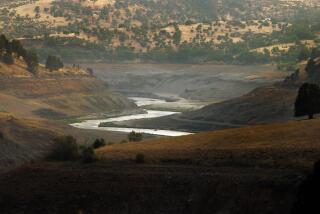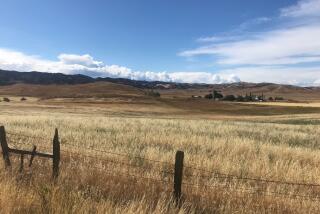A Reservoir of Pride, Dread
- Share via
YICHANG, China — After a decade of construction and the forced relocation of half a million people, China closed the sluice gate Sunday at the Three Gorges Dam, a major step toward creating the huge reservoir on the Yangtze River that will power the world’s largest hydroelectric project.
The dam will begin generating electricity for Shanghai and other energy-hungry cities by August, state officials said. But the project is still at least five years from completion, with 600,000 more people due to be moved.
The official launch of the reservoir was a subdued affair here at the dam site, with a ceremony put off by the SARS crisis and the water slowly starting to fill an upriver basin 350 miles long.
Still, the milestone was roundly lauded by the state media, which sometimes describe the $25-billion project as the nation’s grandest engineering feat since the Great Wall. But it was widely lamented by critics in and out of China, who say the project will unleash widespread ecological and archeological harm and forever alter some of the most magnificent scenery on the world’s third-longest river.
Some of those conflicting sentiments were on display Saturday night in the relocated village of Maoping, where tens of thousands of residents who used to live along the river now gaze down upon it, and the gigantic dam, from high-rise buildings set up in the hills. Many consider themselves lucky to at least be nearby: Some peasants have been moved by the government to factory jobs in faraway cities or to construction projects in the remote Xinjiang region of China’s northwest.
“It makes me very proud for China,” said Lu Yenshang, 34, an agricultural official who was gazing at the project with his 9-year-old son, Yingqi, as the surrounding mountains turned purple in the hazy sunset and floodlights came up on the dam. “When you build the biggest dam on Earth, people know you have a great nation.”
Fu Hua, 31, was far more conflicted. The dammed Yangtze would soon begin rising over his former life below, where he tended orange groves and lived in a house near the river.
“What can I do?” said Fu, shrugging as he pointed toward the groves that will be submerged. “The government says it needs my land.”
Indeed, the government says it does, appealing to residents in river towns on patriotic grounds with the slogan, “Forsake the small home in order to support the big home.” It has offered compensation and new housing in its relocation program, though the multibillion-dollar effort has been tainted by corruption charges and claims by many that the money is far less than originally promised.
Despite such complaints, the dam project is moving ahead, fulfilling a vision first laid out in 1919 by Sun Yat-sen, the leader of the Republic of China, and later championed by Mao Tse-tung. Mao wrote poetry about “a stone wall in the river,” and the Yangtze’s “high gorges spanning a placid lake.”
China’s case for the dam, which is five times as wide as Hoover Dam, is threefold.
Officials say it will generate huge amounts of electricity, perhaps as much as 12% of the supply in a country whose growing economy is sparking ever-greater power demands. They say it will help control the periodic flooding that has killed thousands of people at a time. And, they say, it will improve navigation on the Yangtze, smoothing some of the most treacherous passages and allowing large oceangoing cargo ships to travel much farther inland.
Opponents say many of those goals, especially flood control, could have been attained with a series of equally effective but less grandiose projects along the river.
They also say the dam may lead to erosion problems and is about to create a toxic dump of nightmarish proportions, as the reservoir will fill with enormous volumes of factory and chemical waste, as well as sewage, that are routinely discharged into the river.
Trash dumps and thousands of graves are also due to be washed over.
Rounding out the mess is an anticipated problem of rats migrating up the hills as the river rises, which officials are dealing with by scattering tons of poisoned rice along the riverbank; the poisoned rats, too, will collect in the reservoir.
Some Chinese engineers and foreign consultants have criticized the project’s design and raised the specter of a catastrophic failure of the structure, a scenario Chinese officials have dismissed as absurd.
Last week in Beijing, at a briefing on the progress of the dam, officials with the Three Gorges Project Construction Committee acknowledged that “hair-width fissures” had been found during recent inspections but said the tiny cracks were nothing to worry about.
“Generally speaking, this dam is safe and meets all the design requirements,” said Chi Wenjiang, a project spokesman. Li Haibo, a senior engineer for concrete testing, said that the fissures were normal and that the project had some of the most advanced safety and construction features in the world.
While the official apparatus has been celebrating the progress on the dam, opponents say ordinary Chinese will pay a heavy toll, especially because the billions poured into the dam could have been spent on other priorities, including health care and environmental cleanup.
“This is not a great day for China,” said Dai Qing, a social critic and environmental journalist who was imprisoned for 10 months in 1989 and 1990 for leading opposition to the Three Gorges project as it neared its construction phase. “It’s a sad, painful day for China.”
Beyond the environmental and fiscal concerns, the dam’s impact on China’s cultural heritage has only added to the controversy: The Three Gorges area is full of temples, stone carvings and graves that will be submerged by the new reservoir.
Authorities say they cannot save everything but have set aside $135 million to protect the most important relics and plan to open a museum filled with such treasures.
Besides, they say, the project has created a major new sightseeing draw to the area: the dam itself.
The magnificent, often mist-shrouded Three Gorges -- the Qutang, the Wu and the Xiling -- will remain visible as the reservoir fills, but will appear smaller because the river level will be several hundred feet higher than before.
Tour companies had been marketing trips this spring as the last chance to see the gorges in their entirety before the reservoir began to fill, but the epidemic of severe acute respiratory syndrome led to a steep fall-off in tourists, both from China and abroad.
Here in Yichang, a big city on the river that is host to the construction teams and encompasses the village where the dam is based, there was plenty of official excitement about the next phase of the project. Visitors to the area get an instant message on their cell phones, welcoming them to “the world’s hydropower city,” and many here believe the project will bring them great benefits.
At the Orange City apartment complex, a set of high-rise buildings with a distant view of the tops of the mountains in the gorge area, several residents said their smoky factory town was long due for any kind of a boom.
“Maybe everybody will know where Yichang is now,” said Wu Chengfeng, who works in a trouser factory. “Maybe we will become a little Shanghai.”
But many others were deeply skeptical that the dam will bring prosperity here, however much power it generates.
“All that electricity will go off to Shanghai; it will go to other cities,” predicted a 40-year-old laid-off worker who gave only his family name, Zhang, because he said he feared official punishment for saying anything against the dam. “And we will still be using this,” he said, holding up a piece of coal, which is ubiquitous here and used for both cooking and heating.
Another man, who lost his job a few months ago as a clothes dyer, said: “The Three Gorges project didn’t solve anything for me. I was laid off, and I’m still laid off.”
More to Read
Sign up for Essential California
The most important California stories and recommendations in your inbox every morning.
You may occasionally receive promotional content from the Los Angeles Times.













